PU'UHONUA O HONAUNAU NHP
A Cultural History of Three Traditional Hawaiian Sites
on the West Coast of Hawai'i Island

|
PU'UKOHOLA HEIAU NHS • KALOKO-HONOKOHAU NHP • PU'UHONUA O HONAUNAU NHP A Cultural History of Three Traditional Hawaiian Sites on the West Coast of Hawai'i Island |

|
|
Site Histories, Resource Descriptions, and Management Recommendations |
CHAPTER VII:
PU'UKOHOLA HEIAU NATIONAL HISTORIC SITE (continued)
K. Significance of Resources Within Pu'ukohola Heiau National Historic Site
1. Establishment of the National Historic Site
In June 1929 the Order of Kamehameha unveiled a bronze plaque commemorating the site of the temple of Puukohola, the first formal commemoration of its importance in Hawaiian history in modern times. Pu'ukohola was designated a national historic landmark on June 10, 1966. Finally, on August 17, 1972, the President of the United States signed Public Law 92-388 (92nd Congress, H.R. 1462) authorizing establishment of Pu'ukohola Heiau National Historic Site. This unit of the National Park Service contains some outstanding cultural resources of great significance to the Hawaiian people.
Pu'ukohola is one of the most famous heiau in the islands because of its historic connections with Hawaiian social, political, and religious systems. Its importance is due especially to its association with King Kamehameha, the leader who molded the Hawaiian Islands into a unified political, social, and cultural entity. The national historic site also includes the Mailekini and submerged Hale-o-Kapuni heiau, the ancient royal courtyard of Pelekane, and other evidences of early Hawaiian occupation, such as prehistoric and historic house sites and grave sites and standing and buried ruins of other features of human occupancy.
Pu'ukohola and Mailekini are among the largest and most conspicuously located of the remaining heiau ruins on Hawai'i Island and are also the most accessible. They are especially interesting because references to them and to activities in Kawaihae and the surrounding area exist in both ancient Hawaiian mythology and in historical documents. Another extremely important component of the site is the homestead of John Young, the English advisor to Kamehameha who was instrumental in the latter's rise to power and continued thereafter to promote the interests of the Hawaiian people in every way he could.
The variety of resources present makes the park an ideal location in which to interpret Hawaiian religious practices, architectural styles, construction techniques, political activities, and lifestyles, in both prehistoric and historic times. The purpose of designating the area a national historic site was to preserve a vignette of both prehistoric and historic Hawai'i through restoration and stabilization of selected historical features and their settings. [212]
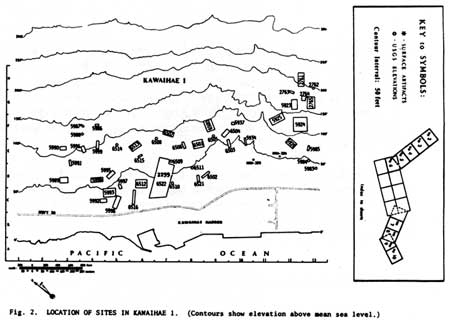 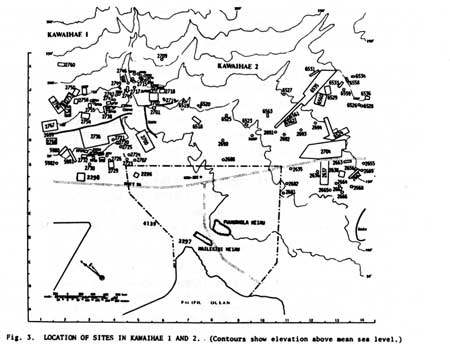 |
| Illustration 71. Location of archeological sites in Kawaihae 1 and 2. Figures 2 and 3 in Barrera, "Archaeological Survey of the Waimea to Kawaihae Road Corridor," pp. 5-6. |
2. Pu'ukohola Heiau
The two most impressive structures, and the ones most visible upon entering the park, are the heiau platforms of Pu'ukohola and Mailekini. Pu'ukohola is considered the most important structure associated with the founding of the kingdom of Hawai'i by Kamehameha. According to tradition, its construction was originally undertaken to invoke the help of Ku-ka'ili-moku, Kamehameha's war god. The temple attained more power and accellerated Kamehameha's ascendancy to the throne when, due to a set of fortuitous circumstances not yet completely understood, its first sacrificial victim proved to be Kamehameha's chief political rival. Probably religious activities ceased at Pu'ukohola upon the abolition of the ancient religious system in 1819, and its platform structures were destroyed at that time.
The west coast of Hawai'i Island contains some very historically significant heiau, such as Hikiau at Napo'opo'o; Ahu'ena at Kailua; Hale-o-Keawe at Pu'uhonua o Honaunau; and Mo'okini farther north up the coast in Kohala District, one of the first luakini built by the high priest Pa'ao. Pu'ukohola is one of the most imposing of these ruins and is considered the last major heiau constructed on Hawai'i Island and in the entire chain. [213] It is also significant as a type specimen of a hale o Ka'ili, a temple associated primarily with the feathered war god Ku-ka'ili-moku. [214]
Pu'ukohola Heiau is considered a highly significant cultural site because it is the only structure in the islands directly associated with the founding of the Hawaiian kingdom. It is the spot from which Kamehameha, having established his supremacy by the sacrifice of his chief rival on the temple altar, launched his final successful effort to conquer the rest of the Hawaiian Islands. [215]
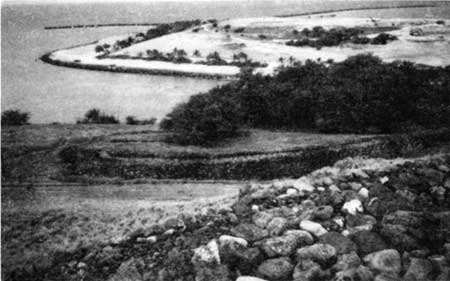 |
| Illustration 72. View toward coral stockpile from Pu'ukohola. Mailekini Heiau lies halfway down the hill and the site of Hale-o-Kapuni is beyond, in the water near shore. |
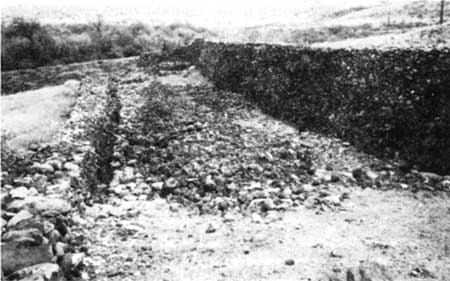 |
| Illustration 73. View to north along platform of Mailekini Heiau. |
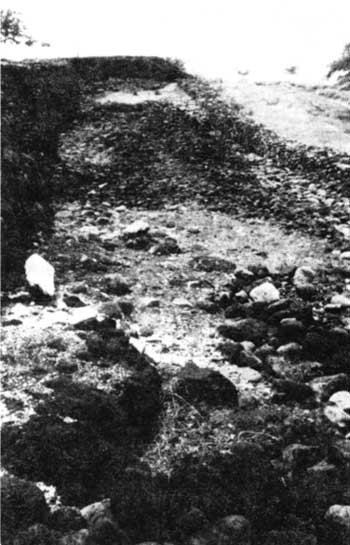 |
| Illustration 74. View to south along platform of Mailekini Heiau. Note disturbed burial area at north end. NPS photos, 1989. |
3. Mailekini Heiau
Mailekini's time of construction and early use are conjectural because its time of major significance was during the prehistoric period when records were not kept — during the early period of warfare between the chiefs of Hawai'i Island and between them and the rulers of the other islands in the chain. It appears to have been one of the primary temples of the ruling chiefs of Kohala and was thus, in addition to being a significant religious and political symbol, a highly-sought-after prize for rival powers. Historical documentation indicates that little if any religious activity took place at Mailekini during the historical period. Its use in conjunction with religious activities at Pu'ukohola has been hinted at but never substantiated. In the early 1800s Kamehameha ordered it fortified to protect the royal residential area and the militarily strategic bay at Kawaihae. The precise date of dismantlement of the structure is not known, although, as noted earlier, there is an indication that in the year 1816 some of the cannon were removed by Gov. John Adams (Kuakini), who was instructed to take seven "great guns" from Kawaihae to O'ahu. [216] Years later, around the turn of the century, the local populace began using Mailekini as a cemetery.
4. Hale-o-Kapuni Heiau
The submerged heiau site of Hale-o-Kapuni is a tantalizing resource because its presence is suggested both by Hawaiian oral tradition and by local informants as well as by very scant statements by some early foreign visitors. Any remains of the structure are assumed to be buried under silt resulting from harbor construction activity. This site would be very significant in the cultural history of the area, but to date the precise extent of its remains, the period of its use, and the rituals connected with it are unknown. Traditionally thought to have been dedicated to the shark gods, its significance would lie in its illustrating a different kind of deity worship than that at Pu'ukohola, one concerned with placating the 'aumakua spirits. It is thought to also predate Pu'ukohola, but its relationship to that structure and to Mailekini is unclear.
5. John Young Homestead
The John Young homestead is a significant part of the story of the development of modern Hawai'i, for Young was responsible for much that occurred, and the directions its leaders took, in its formative years. Historian Russell Apple states that the homestead of John Young is nationally significant because of its association with a man and events important in the founding and early decades of the Hawaiian kingdom. It is also significant as the place of origin of a chiefly Hawaiian family. [217] John Young took part in, or witnessed, every event of social, religious, and political significance from Kamehameha's rise to power through his establishment of the Hawaiian kingdom, a period spanning the years 1790 through 1820.
During that time he functioned as Kamehameha's most important military, diplomatic, and economic advisor, in addition to serving as governor of Hawai'i Island. He was responsible initially for providing the technical expertise in the use of firearms and the basics of military strategy that enabled Kamehameha to conquer his enemies and unify the Hawaiian Islands. Apple has observed that Young, as a transplanted foreigner, had no friends or family connections in the islands and therefore placed his loyalties on the side of his benefactor, the king, from the beginning. He was entrusted by Kamehameha with resources that in the hands of native chiefs could have been amassed and turned against the king. These resources over which he had charge included warriors, agricultural lands, and military and naval equipment and stores. Young's second marriage, to a niece of the king, further strengthened their ties. [218]
After establishment of the kingdom, Young, as Kamehameha's chief economic advisor and business agent, supervised the regulation of Hawai'i's commercial intercourse with the world, directing all the special economic ventures of the king, such as the sandalwood business, facilitating foreign trade by acting as liaison between sea captains and the Hawaiian government, and ensuring fair treatment for all parties. Young's home became an important social and business center, a focal point of activity in the early years of the kingdom. There he entertained visiting sea captains, traders, explorers, foreign dignitaries, and missionaries. Socializing mixed with serious discussion as much of the governmental foundation for the kingdom was laid. Young even mentioned that in the earliest days, "The great one [Kamehameha] comes to use my cook house several times." [219]
Young was instrumental in gaining goodwill and support for the Kamehameha dynasty through sage diplomatic advice to a leader untutored in the political realities of a foreign world. By all these means, Young succeeded in minimizing the difficult and often confusing pressures of acculturation on Hawaiian society. After Kamehameha's death, Young's influence waned, although he continued to be held in high esteem by the new monarch, his adopted countrymen, and European and American visitors until his death. Due to his influence, American missionaries were allowed to land soon after the kapu abolition, initiating a strong American influence in the islands that ultimately led to statehood.
The homestead's importance also stems from its architectural significance: it contains the first known examples of Western-style structures built in the Hawaiian Islands. This group of buildings reflected both European and Hawaiian architectural styles. Although the main house on the upper portion was plastered-over stone with mortar, other houses nearby were of native construction and were possibly where his wife, his children, and their servants lived. [220] Probably the more permanent quality of these structures as compared to the traditional Hawaiian thatched huts appealed to Kamehameha, for Apple notes that later a few Western-style structures were built in some of Kamehameha's various palace complexes — at Kailua-Kona, Honolulu, Lahaina, and Kealakekua Bay. [221] As early as 1929, talk arose about establishing the Young house and the area around it as "The John Young Park," a plan reportedly favored by the governor. [222] The structural remains of the homestead were included within Pu'ukohola Heiau National Historic Site in 1972. The complex is also listed in the National Register of Historic Places. It is a unique archeological site related to early Hawaiian history, although much information on it is still lacking.
6. Other Resources
Other resources in the park include a number of archeologically rich sites connected with aboriginal Hawaiian occupation of the area. The only other structures besides the heiau within the park that have been found in early pictures include thatched houses in the Pelekane area and the church located to the south near Spencer Beach County Park.
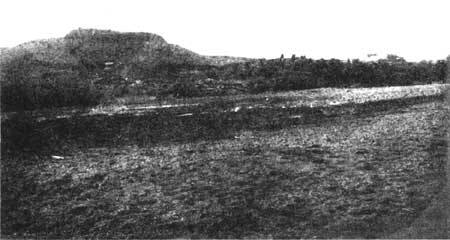 |
| Illustration 75. View to southeast of Pu'ukohola and Mailekini heiau. This undated photo, showing what appears to be a church to the right, might date from the 1880s. Courtesy Hawaiian Historical Society, Honolulu. |
In 1964 Lloyd Soehren conducted a reconnaissance survey of the lands in the vicinity of the Mauna Kea Beach Hotel. His survey, which included the park area, found fishermen's stone-walled shelters or campsites, animal enclosures with fieldstone walls, house floors and platforms, stone-enclosed cultivation sites, an old beach trail, graves, and house lots with artifactual remains. Within the park specifically, he noted, in addition to the three heiau, Kamehameha's stone seat, the conjectural location of the Waiakane Spring, the Young homestead, and, in the Pelekane area, house platforms, stone walls, animal pens with stone walls, house floors, modern pictographs, house lots, a concrete-lined well, the possible site of Young's "old house," and an old-style charcoal oven, as well as the old beach trail running along the ocean, a gravesite south of the stone chair, and later house sites in the area along the shore and inland near Spencer Beach Park. [223] Many of these remains are significant as indications of extensive agricultural activity, especially east and south of the heiau. They tend to support the contentions of older local residents that in aboriginal times there were more water, more rainfall, and more springs. The house sites and stone wall enclosures appear to be post-European in date, but evidence of earlier temporary campsites is present. [224]
In 1980 Soehren published the results of a survey of a portion of land in Kawaihae 2 extending from the shore inland to the Queen Ka'ahumanu Highway and from Waiulaula Stream north to the Waimea-Kawaihae highway. Although not within the park, the features he found are of interest in illustrating the type of activity in the immediate area of the heiau. Soehren found agricultural features in the form of garden plots surrounded by stone fences and traces of irrigation ditches, which are thought to have supported sweet potato and watermelon crops until after World War II. He found evidence of habitation sites ranging from temporary campsites, or C-shaped windbreaks, to fenced house lots supporting temporary houses. Soehren suggests that some of these windbreaks in the area, of which there are many on the Kohala slopes, might have been used by the work force building Pu'ukohola Heiau. Soehren also found military foxholes (or rifle pits) from World War II in the area, characterized by low fieldstone walls, C shapes, and floors about a foot deep. Several lie on the slopes back of Spencer Beach Park, but most are along the high ridge on the north side of Waiulaula Stream. In some cases the military adapted aboriginal features to this use. The remains of temporary houses found were probably used by upland families journeying to the ocean to make salt and to dry fish. Most of those house sites had been occupied in historical times as well, and some into the 1900s. [225]
The analysis presented by Dorothy Barrère relative to archeological findings in the Waimea Kawaihae area is that early occupation there probably resulted from periodic movements back and forth through the area related to exploitation of upland forest and marine resources. In the sixteenth through the eighteenth centuries, there appears to have been longer-term seasonal use and perhaps some permanent occupation with limited raising of crops such as plantains, bananas, and taro in small garden plots. In time more intensive agricultural activity began as more land was cleared and residential sites became permanent in the late prehistoric to early historic period. The presence of the royal compound at Pelekane would probably have drawn people to the area and provided impetus for construction of homes and food production. The focus on trade in the late 1840s and early 1850s in the Kawaihae-Waimea area concentrated on increased production of potatoes for a short while. Meanwhile, introduced cattle became a big problem, resulting in the construction of rock-walled exclosures. The settlement pattern here, as shown in early photographs and as suggested by surface remains around the heiau, was one of dispersed residential complexes with associated agricultural plots or fields. [226]
| <<< Previous | <<< Contents >>> | Next >>> |